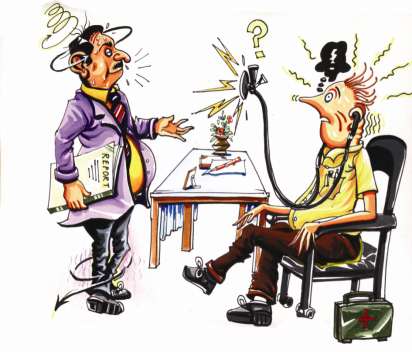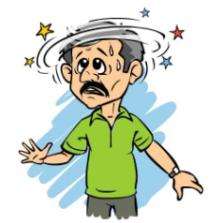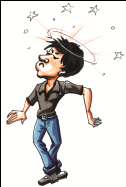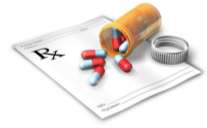Rational medical therapy of vertigo


Dr Anirban Biswas
-neurotologist
Kolkata, India


Cinnarizine??
Betahistine??
Prochlorperazine??
Dimenhydrinate??
Ginkgobiloba??
None of the above??
Psychotropic drugs??
Reassurance??
Anirban Biswas, neurotologist


Provide symptomatic relief – taking care of the
inherent ill-effects of anti-vertigo drugs
Diagnose the cause of the vertigo and treat the cause
of the vertigo rather than merely suppress &
camouflage the symptom of vertigo
Restore the deranged balance function
Try to improve the neuronal metabolism, improve
cognition & correct any concomitant psychological /
cognitive disorder
Anirban Biswas, neurotologist


Vertigo / imbalance is just a symptom or manifestation
of an underlying disorder; the causative pathology needs to be known for treatment
Symptomatic treatment with anti-vertigo drugs may
relieve symptoms but will not cure the causative
disorder
Objective of management is to correct the cause, (not
merely suppress the symptom) and to promote vestibular compensation
Sensory epithelium is non-mitotic; dead vestibular cells
do not regenerate once damaged
Anirban Biswas, neurotologist
Restoration of deranged balance function after the
vestibular labyrinth is damaged is possible only by
vestibular compensation which is a natural process
Drugs that depress the CNS jeopardise the central
compensatory mechanism and inhibit vestibular
Peripheral vestibular disorders are usually self-limiting and
do not require perpetual /eternal drug therapy with vest
Central disorders usually present with imbalance;
suppressing vestibular sensitivity by vestibular sedatives will
aggravate the imbalance as CNS gets deprived of normal
vestibular input
Anirban Biswas, neurotologist
• Vertigo / imbalance and psychogenic disorders are
co-morbid conditions; the psychogenic part needs
effective management
• Neurotropic agents / antioxidants / cognition
enhancing drugs have a positive role in the
management of balance disorders
Prolonged use of antivertigo drugs is hazardous and
detrimental to the balance system; current
recommendation for duration of therapy with
antivertigo drugs is 3-5 days maximum 7 days
Anirban Biswas, neurotologist
BPPV Vestibular neuritis Migraine related vertigo
Specific therapies exist for all of
Phobic postural/ psychogenic vertigo Labyrinthi
and none require long
Meniere's disease Vestibu
contd lar siez
non-ures
specific therapy with
Sensory ataxia /posterior column lesions Ototox
vertigo drugs
Central vertigo due to oculomotor or other CNS
diseases like extrapyramidal disorders
……………
Anirban Biswas, neurotologist
Balance disorder patients are not just
---they have a lot of other problems
like irrational behaviour, poor concentration, forgetfulness
They have COGNITIVE deficits and show poor cognitive skills in the
domains of:-
- memory,
- concentration,
- arithmetic and reading
they also have psychological and emotional disorders
VERTIGO or IMBALANCE are just one of their many problems
A HOLISTIC MANAGEMENT is NEEDED
Vestibular sedatives
-do they help or harm?
Increasing cerebral & inner ear blood flow
-does it really help in all patients?
Exercises for vestibular compensation
-does it have any role?
Neurotropic agents and antioxidants
- are they helpful ?
Psychotropic drugs
- any role to play?
Anirban Biswas, neurotologist
-PROCLORPERAZINE
-DIAZEPAM
How do these drugs provide symptomatic relief ?
- receptor blockage in cholinergic pathways
- inhibiting vestibular nuclei
- decreasing discharge rate in the vest nuclei
- sedating the CNS
All these processes INHIBIT the central
vestibular compensatory mechanism
sensory conflicts that increase vertiginous
symptom enhances compensation
Anirban Biswas, neurotologist
Vestibular nuclei
Input from left and right vestibular system remains of
similar intensity (e.g. of size ‘50') under normal conditions
Anirban Biswas, neurotologist
Vestibular nuclei
More the difference between the 2 sides, more is the sensory conflict ; More the sensory conflict, more is the vertigo and better is the vestibular compensation
Anirban Biswas, neurotologist
vestibular nuclei
Vestibular suppressants depress labyrinthine i.e. peripheral vestibular function bilaterally
Anirban Biswas, neurotologist
vestibular nuclei
Bilateral suppression reduces the difference between the intensity level of input between
the two sides(30 6) thereby providing temporary relief from vertigo.
However this reduces the sensitivity of the balance system and
inhibits compensation both of which are undesirable. Anirban Biswas, neurotologist
Providing symptomatic relief for the first few
days suffices in most cases as these
peripheral vestibular disorders are self-limiting
conditions; anti-vertigo drugs MUST be
discontinued after acute symptoms subside
and not continued eternally
The deranged balance function is naturally
restored by the process of central vestibular
compensation that can be enhanced and
expedited by vestibular rehabilitation
Anirban Biswas, neurotologist
Advantages:-
- ameliorates patient's physical distress of vertigo - & nausea/vomiting
- relieves patient from severe mental distress &
anxiety that accompanies the vertigo
Disadvantages:-
- camouflages the underlying disease which remains
- jeopardises the natural process of VESTIBULAR
COMPENSATION ingrained in our systems
Anirban Biswas, neurotologist
Is cerebral hypoxia the only cause of vertigo??
If not, then why use drugs to enhance cerebral blood supply in every pt. of vertigo ?? Do we need to increase cerebral / inner blood flow in a 30 yr old patient who has presented with acute vertigo and no other symptom ??
Anirban Biswas, neurotologist
only when there is other evidence of cerebral hypoperfusion like
dysarthria, dysphagia, other lower cranial nerve
deficits as isolated acute vertigo is practically never
caused by vertebrobasilar insufficiency
cerebral hypoxia may be the expected cause in aged vasculopathic subjects suffering from chronic vertigo along with other symptoms like dementia
Excessive vasodilatation e.g., with Ca+ channel blockers causes dizziness, hypotension, headache, flushing, nausea etc …pg 836 Goodman &Gillman
Anirban Biswas, neurotologist
VESTIBULAR COMPENSATION is the mainstay of therapy in
peripheral vestibular lesions
VESTIBULAR COMPENSATION is enhanced and facilitated
by VESTIBULAR REHABILITATION THERAPY (VRT) which are exercises consisting of HEAD / BODY / EYE movements to increase sensory conflicts.
Recurrence of symptoms are often due to decompensation
and not due to recurrence of disease, hence re-initiation of exercises is the recommended protocol for recurrence of symptoms
Even if drugs for symptomatic relief are used, only such drugs
are to be chosen that do not inhibit vestibular compensation i.e., do not cause sedation / CNS depression
-Cawthrone Cooksey exercises :-
-Yogic asanas :-
-Taichi exercises :-
Anirban Biswas, neurotologist
1. PYRITINOL 200mg BD
- enhances uptake & utilisation of glucose and O2 in CNS,
-enhances cholinergic transmission & cerebral microcirculation
2. PIRACETAM 2.4gm daily.
- improves microcirculation,
- prevents neuronal hypoxia,
- enhances neurotransmission
-enhances cognition
3. ANTIOXIDANTS (ginkgobiloba), 120 mg daily
-prevents oxidative damage in inner ear and brain tissues
1. Psychologic symptoms & psychiatric disorders are
common in patients of vertigo/imbalance -
COMORBIDITY.
2. Vertigo/imbalance & psychiatric disorders co-exist as
a result of neurological links between vestibular &
autonomic systems- NEUROANATOMIC
3. Uncertainty of severity/timing of the attack &
inefficiency of diagnosis/treatment
leads to anxiety, helplessness,
panic disorders, agoraphobia,
somatisation, depression.
5. Vestibular disorder patients have very high incidence
of abnormality in psychometric test.
6. Better clinical outcome provided when psychotropic
drugs are combined with vestibular drugs in many
patients of vertigo.
7. Neuroanatomical connections have been established
between vestibular and autonomic nervous systems.
Anirban Biswas, neurotologist
1. Psychologic responses to dizziness can RETARD recovery
and start a Vicious circle of persistent dizziness and
psychological disturbance each helping to perpetuate the
2. Dizziness becomes chronic in patients who react negatively
3. Anxiety & panic caused by the vertigo increases
autonomic symptoms one of which is dizziness. Dizziness
augments the autonomic symptoms.
Anirban Biswas, neurotologist
Diazepam
4. Promethazine
5.
Cinnarizine
6. Betahistine
7.
Meclizine
8. Ginkgo biloba
belongs to the phenothiazine group of antipsychotics
– known to induce extrapyramidal disorders like PARKINSONISM, chorea, acute dystonia with oculogyric crisis, opisthotonus, torticollis etc.
pharmacologically recommended use is as an
has antihistaminic(H1), anticholinergic (muscurinic
M1), antidopaminergic(D2) effects.
best drug for providing symptomatic relief in acute
vegetative features that accompany acute vertigo like
nausea, vomiting are greatly relieved.
by blocking D2 receptors inhibits cortical arousal alertness level is reduced drowsiness ensues.
Because of its CNS depressant effects patient has to
start vestibular exercises immediately such that inhibition of vestibular compensation can be counteracted by expediting compensatory mechanism through rehabilitation exercises.
Best avoided in patients presenting with INSTABILITY
Available as 5 mg tablets and 12.5mg/ml injection
A sublingual preparation is available .
If oral preparation can not be used because of
severe nausea, a single injection of 12.5mg usually suffices.
A single oral dose of 5 to 10 mg is reasonably
effective. If vomiting persists then 5mg TDS for 1 to 3 days (max-5days) may be used.
Extrapyramidal effects like acute dystonic reactions,
oculogyric crises, pseudo parkinsonism and akathisia are the major drawbacks - more common in children and adolescents.
can also cause a life threatening condition called
neuroleptic malignant syndrome
sublingual preparation sometimes causes local erosive
cheilitis of lips and tongue (patient can swallow the tablet in such situation)
Hypotension, esp orthostatic hypotension can occur anticholinergic effects are often distressing for the pt
Very effective/ best drug for symptomatic relief
Relieves both vertigo as well as nausea-vomiting
CNS depressant- hence very likely to inhibit vest. comp.
Significant side-effects: e.g. extrapyramidal reactions,
hypotension, anticholinergic effects
Best used for a very short course to relieve acute
symptoms
Provides good symptomatic relief
Increases blood supply to the brain and inner ear
Not known to have any teratogenic effect
Too many side-effects
Anirban Biswas, neurotologist
Anticholinergic- competitive antagonsit of histamine
at H1 receptors and blocks cholinergic transmission not only in higher vest pathways but also other pathways
Antidopaminergic – blocks D2 receptors and block
the release of dopamine
Ca- channel blocker- prevents entry of Ca-ions in the
labyrinthine cells and in the smooth muscles of blood vessels
Anti-5HT properties – antagonises 5HT or serotonin
which regulates GI motility and provides sense of wellbeing
CINNARIZINE – mech of action
Action of cinnarizine for relief of vertigo is exerted
1. CNS depression 2. Inhibition of vestibular labyrinth (thereby reducing
sensory conflict)
3. Receptor blockage in histaminergic and cholinergic
4. Decreasing the discharge rate in vestibular nuclei
+ increases blood supply to the inner ear and brain, hence
helpful if vertigo is caused by hypoxia of brain/inner ear
Available as 25 mg and 75 mg tablets
75 to 225mg tds for 5-7 days
Long continued use can induce undesirable
Due to anticholinergic properties-
1 Xerostomia 2 Dry sore throat 3 Warm,blotchy,red skin due to decreased
epidermal thermal dissipation
4. Increased body temperature 5. Mydriasis,photophobia 6. Cycloplegia-loss of accomodation 7. Diplopia
8. Increased intraocular pressure 9.Loss of coordination 10.Tremors 11.Tendency to be easily startled 12.Tachycardia 13.Urinary retention 14.Diminished bowel movement-sometimes
paralytic ileus(via vagus)
Due to anti-dopaminergic properties (due to
prevention of MgATP dependent production of electrochemical gradient-lowered level of dopamine in basal ganglia neurons)
1 ) Depresssion 2) Tremor 3) Muscle rigidity 4) Akathisia 5) Tardive dyskinesia 6) Drug induced Parkinsonism-due to its affinity for
the D2 receptors in the stratum of brain
Due to Ca channel blocking properties-affect
depolarization in SA and AV node and also affect AV conduction -a negative inotropic effect is produced in the cardiac cells.
Pedal edema occurs as smooth muscles in
vascular wall are prevented to contract
Throbbing headaches occur commonly
labyrinthine sedative effect ; hence provides
reasonably good symptomatic relief.
anti-vasoconstrictive effect reduces slugging phenomenon of blood in narrow
stabilises vascular endothelium Anticholinergic drug hence induces CNS depression Side effects like pedal oedema, drowsiness,
extrapyramidal symptoms like Parkinsonism/ tremor anticholinergic effects,
Provides symptomatic relief
Increases blood flow to brain and inner ear
Does not depress the CNS
Only non-sedative antivertigo drug without any
anticholinergic and antidopaminergic effects
Mechanism of action not very clear Controversies in dosage (24-900mg/day)
Anirban Biswas, neurotologist
Structural analogue of histamine Agonistic action on H1 receptors Antagonistic action on H3 receptors
1. Inhibition of labyrinth reducing sensory conflict
2. Decreasing discharge rate in vestibular nuclei 3. Increasing blood flow; esp in stria vascularis of
inner ear which may have an effect in reducing endolymphatic hydrops
4. Claimed to enhance arousal and also expedite
vestibular compensation
Anirban Biswas, neurotologist
• The increased blood flow is due to its action
both on H1 and H3 receptors
• The much hyped H1 agonistic action is pretty
weak-this action was observed only at levels which were 100 fold higher than therapeutic.
• Moreover this action is negated by the
antihistaminic group of drugs
• However due to its H3 antagonistic effect ?some
increase in vestibulo-cochlear blood flow may be possible
Betahistine has been shown to enhance
vestibular compensation and facilitate recovery of balance function in a 1995 study by Tighilit et al
But this study was on cats and not a human
study and dose used was 100 times the recommended therapeutic dose for humans.
Anirban Biswas, neurotologist
It has been claimed that betahistine enhances
restoraton of vestibular function through central adaptation by activating central histaminergic system through a vestibular-hypothalamus-vestibular loop.
It induces excitatory effects on the neuronal
activity at cortical and subcortical levels by activating H1 receptors.
-Betahistine available as 1. Dihydrochloride. 2. Mesilate
-Dose is controversial :-Therapeutic recommendation
32-72mg/day but some centers promote 600-900
mg/day in Meniere's disease.
5-7 days at 72mg/day for symptom control
2-3 mths at 96- ?? mg/day for confirmed MD
Different allergic and skin related side effects and
hypersensitivity reactions like tingling, numbness, burning sensation, resp.distress can occur due to increased histamine level
To be used with caution in asthmatics and peptic
ulcer pts as it is a mild H2 agonist and can enhance gastric secretion
Systemic administration causes peripheral
vasodilatation and a fall in systemic blood pressure-so use of very high dose should be avoided.
Competitively antagonizes the actions of
histamine at H1 receptors
Anticholinergic effects are lesser compared to
other conventional antihistaminics
Sedation induced is minimal. Anti emetic and antivertigo effects are as
good as that of dimenhydrinate
Approved as OTC product by FDA hence
safety profile is very good
No teratogenic effect.
Adverse effects are due to both anticholinergic
and antihistaminic properties though very mild in nature.
Available as25 to 50 mg tablets.
Specially useful for various forms of motion
sickness-has to be taken before undertaking the journey.
Reasonably good vestibular sedative with
antiemetic properties
CNS depressant, likely to depress Vest. Comp mech
Does not increase cerebral / inner ear blood flow
Less pronounced anticholinergic activity hence
much less side effects though as effective as other antihistamine anti vertigo drugs
Best used for symptomatic relief for 3-5 days
Conventional antihistaminic with high
anti-cholinergic activity.
Mechanism of action: inhibits spread of
hyperactive vestibular input via MLF to centers for vegetative regulation in medulla -e.g-centers for heart rate, respiration, vomitting, sweating etc.
Thus very effective in acute vertigo with
pronounced vegetative symptoms
Absence of extrapyramidal features is the biggest
advantage of this antiemetic.
ADVERSE EFFECTS: Highly sedative-impairs
psychomotor skill.Concomittant use of alcohol or other CNS depressant should thus be discouraged.
Best avoided in breastfeeding mothers Better avoided in patients having enlarged
prostate, glaucoma, emphysema, chronic bronchitis. – applies to other anticholinergics too
At very high doses it can affect colour
discrimination, night vision, visual reaction time, stereopsis.
Available as 50 mg tablets 50-100 mg 3 to 4 times daily is the dose which
should best not be exceeded.
3 to 5 days is usually sufficient for an optimal
A combination of Cinnarizine 20 mg and
Dimenhydrinate 40 mg per tablet is now available- an effective and well tolerated treatment option.
CNS depressant, hence best discontinued as
soon as acute symptoms subside (3-5 days)
antiemetic effect not associated with extra
pyramidal features
very effective in acute vertigo with
pronounced vegetative symptoms
tranquilising & anxiolytic effects decreases resting activity of vestibular nuclei ; hence
provides symptomatic relief
acts upon the reticular formation and limbic systems
in the brain hence reduces concomitant anxiety
dramatic effects in psychogenic vertigo CNS depressant – hence best avoided Just one or two doses to control symptoms in very
Improves health of endothelium in blood vessels and hence
increases transport through blood brain barrier
Improves arterial / venous tone in hypoxic areas
Decreases platelet agglutination
Inhibits oxygenated free radicals
Has to be continued for a minimum of three months
Does not provide relief in acute vertigo, but has been shown to
be effective in aged vasculopathic patients suffering from
chronic vertigo and instability due to central degenerative
-RESTRICT use of symptom relieving anti-vertigo drugs -TREAT the CAUSE of the vertigo which is just a
symptom of some underlying disorder
-EXPEDITE vestibular compensation through physical
therapy as this is the only way to restore balance
-TREAT the concomitant PSYCHOLOGICAL and
COGNITIVE impairment for a complete recovery
Anirban Biswas, neurotologist
Dr. Anirban Biswas
Neurotologist
Bellevue Clinic Kolkata
Vertigo & Deafness Clinic Salt lake Kolkata
http://www.dranirbanbiswas.com
Source: http://www.dranirbanbiswas.com/media/pdf/New%20DRUG%20THERAPY%20and%20RATIONAL%20MANAGEMENT%20of%20Vertigo.pdf
federalevidence.com
United States Court of Appeals For the First Circuit Nos. 11-1904, 11-2096 IN RE: NEURONTIN MARKETING AND SALES PRACTICES LITIGATION KAISER FOUNDATION HEALTH PLAN, INC.; KAISER FOUNDATION HOSPITALS; KAISER FOUNDATION HEALTH PLAN OF COLORADO; KAISER FOUNDATION HEALTH PLAN OF GEORGIA, INC.; KAISER FOUNDATION HEALTH PLAN OF THE MID-ATLANTIC STATES, INC.; KAISER FOUNDATION HEALTH PLAN OF
sasascongress.co.za
SASAS Congress 48 21-23 September 2015 Posters: Industry, Production Microbiological assessment of Suya Meat (an intermediate moisture meat) in Oyo State, South-Western Nigeria A.O. Akinwumi1#, A.A. Odunsi1, E.A. Adebayo2, S.G. Ademola1 & B.S.Olawuyi1 1Department of Animal Nutrition and Biotechnology, Ladoke Akintola University of Technology,